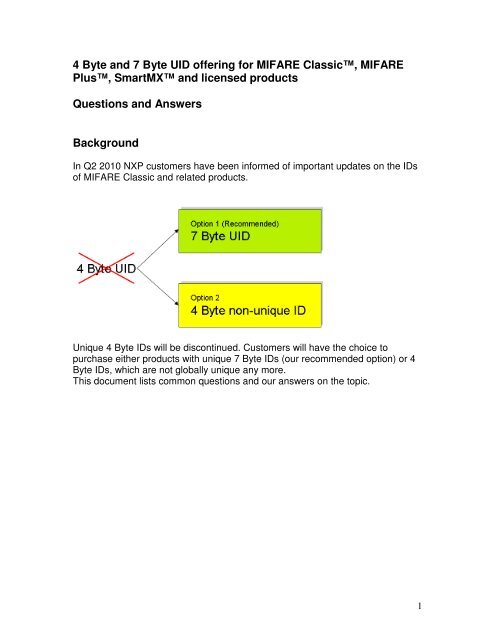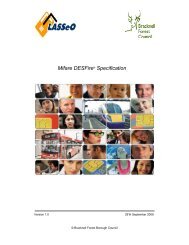4 Byte and 7 Byte UID offering for MIFARE Classic™, MIFARE Plus ...
4 Byte and 7 Byte UID offering for MIFARE Classic™, MIFARE Plus ...
4 Byte and 7 Byte UID offering for MIFARE Classic™, MIFARE Plus ...
You also want an ePaper? Increase the reach of your titles
YUMPU automatically turns print PDFs into web optimized ePapers that Google loves.
4 <strong>Byte</strong> <strong>and</strong> 7 <strong>Byte</strong> <strong>UID</strong> <strong>offering</strong> <strong>for</strong> <strong>MIFARE</strong> Classic, <strong>MIFARE</strong><br />
<strong>Plus</strong>, SmartMX <strong>and</strong> licensed products<br />
Questions <strong>and</strong> Answers<br />
Background<br />
In Q2 2010 NXP customers have been in<strong>for</strong>med of important updates on the IDs<br />
of <strong>MIFARE</strong> Classic <strong>and</strong> related products.<br />
Unique 4 <strong>Byte</strong> IDs will be discontinued. Customers will have the choice to<br />
purchase either products with unique 7 <strong>Byte</strong> IDs (our recommended option) or 4<br />
<strong>Byte</strong> IDs, which are not globally unique any more.<br />
This document lists common questions <strong>and</strong> our answers on the topic.<br />
1
Content<br />
General Questions............................................................................................................... 4<br />
What is a unique identifier number <strong>and</strong> what is it used <strong>for</strong>? .......................................... 4<br />
What is the difference between a 4 byte <strong>UID</strong> <strong>and</strong> a 4 byte ID?...................................... 4<br />
General Questions............................................................................................................... 5<br />
<strong>MIFARE</strong> Classic is a fundamentally flawed product, which has been hacked by several<br />
research groups. Why does NXP even extend its lifecycle by providing 7 <strong>Byte</strong> <strong>UID</strong><br />
solutions <strong>for</strong> it? ............................................................................................................... 5<br />
Would this situation not be a big opportunity to discontinue <strong>MIFARE</strong> Classic <strong>and</strong><br />
provide more secure solutions to the market?................................................................. 5<br />
Visibility on end of life of 4 <strong>Byte</strong> <strong>UID</strong> based products .................................................. 6<br />
Is only <strong>MIFARE</strong> Classic 1K concerned?........................................................................ 6<br />
Quantity of unique numbers left over? ........................................................................... 6<br />
Communication plan of NXP towards the market regarding the need to change to 7 <strong>Byte</strong>s<br />
<strong>UID</strong> ..................................................................................................................................... 7<br />
Towards system integrators (SIs).................................................................................... 7<br />
Towards public transport operators (PTOs)?.................................................................. 7<br />
What will be the timing of the planned communication? ............................................... 7<br />
Communication plan of NXP towards the market regarding the need to change to 7 <strong>Byte</strong>s<br />
<strong>UID</strong> ..................................................................................................................................... 8<br />
What will NXP do to educate the market?...................................................................... 8<br />
Focused on <strong>MIFARE</strong> Classic only?................................................................................ 8<br />
Focused on <strong>MIFARE</strong> Classic 1K only?.......................................................................... 8<br />
Impact on <strong>MIFARE</strong> <strong>Plus</strong> .................................................................................................... 9<br />
Impact on 4 B <strong>UID</strong> version of <strong>MIFARE</strong> <strong>Plus</strong>?............................................................... 9<br />
Will all 8 possible versions remain available?................................................................ 9<br />
Is any simplification of <strong>MIFARE</strong> <strong>Plus</strong> range now <strong>for</strong>eseen? ......................................... 9<br />
Impact on <strong>MIFARE</strong> <strong>Plus</strong> .................................................................................................. 10<br />
Given the <strong>UID</strong> choices <strong>for</strong> <strong>MIFARE</strong> <strong>Plus</strong> will most operators not just choose 4 <strong>Byte</strong><br />
<strong>UID</strong>s by default?........................................................................................................... 10<br />
Scheduled availability <strong>for</strong> <strong>MIFARE</strong> Classic 7 B <strong>UID</strong>...................................................... 11<br />
<strong>MIFARE</strong> Classic 1K with 7 B <strong>UID</strong> .............................................................................. 11<br />
<strong>MIFARE</strong> Classic 4K with 7 B <strong>UID</strong> .............................................................................. 11<br />
Impact on <strong>MIFARE</strong> Implementations NXP SmartMX ICs.............................................. 12<br />
Is the SmartMX dual-interface controller only available with 4B <strong>UID</strong>?...................... 12<br />
Will the next generation of dual interface chips have a 7 B <strong>UID</strong> <strong>for</strong> <strong>MIFARE</strong> Classic<br />
emulation?..................................................................................................................... 12<br />
Impact on Fast Pay ICs ..................................................................................................... 13<br />
Is NXP's Fast Pay product affected by the 4B <strong>UID</strong> issue? ........................................... 13<br />
Impact <strong>for</strong> products from 3rd parties ................................................................................ 14<br />
On pure contactless transport chip from Infineon Technologies .................................. 14<br />
On implementations of NXP licensees? ....................................................................... 14<br />
Implications <strong>for</strong> other NXP smart card ICs ...................................................................... 15<br />
Are <strong>MIFARE</strong> Ultralight, <strong>MIFARE</strong> Ultralight C, <strong>MIFARE</strong> DESFire, <strong>MIFARE</strong><br />
DESFire EV1 <strong>and</strong> <strong>MIFARE</strong> <strong>Plus</strong> (7 B <strong>UID</strong> version) ICs also affected by the 4 B <strong>UID</strong><br />
issue?............................................................................................................................. 15<br />
2
Impact on reader infrastructure......................................................................................... 16<br />
Is the existing reader infrastructure able to support 7 B <strong>UID</strong>? ..................................... 16<br />
Impact on reader infrastructure......................................................................................... 17<br />
Until when does NXP think that the existing reader infrastructure will be able to<br />
support 7 B <strong>UID</strong>? .......................................................................................................... 17<br />
Impact on reader infrastructure......................................................................................... 18<br />
Which solutions does NXP offer in case systems do not support 7 B <strong>UID</strong>? ................ 18<br />
Impact of “non-unique IDs" to existing systems .............................................................. 19<br />
What do non-unique IDs mean <strong>for</strong> the legacy infrastructure?...................................... 19<br />
Is this really usable as we state that uniqueness is key? ............................................... 19<br />
Differences of 4 B <strong>UID</strong> vs. 7 B <strong>UID</strong> ................................................................................ 20<br />
Are there any differences between a 4 B <strong>UID</strong> <strong>MIFARE</strong> Classic <strong>and</strong> a 7 B <strong>UID</strong><br />
<strong>MIFARE</strong> Classic beyond the card activation ("Anticollision")?.................................. 20<br />
Impact of the 4 / 7 B ID topic on NFC ............................................................................. 21<br />
Do all NXP NFC IC's (PN51x, PN53, PN54x <strong>and</strong> PN65x) support a 7 <strong>Byte</strong> <strong>MIFARE</strong><br />
<strong>UID</strong> ?............................................................................................................................. 21<br />
3
General Questions<br />
What is a unique identifier number <strong>and</strong> what is it used <strong>for</strong>?<br />
ISO/IEC 14443 Type A defines a Unique IDentifer to be used <strong>for</strong> card<br />
selection <strong>and</strong> activation. The st<strong>and</strong>ard defines single, double <strong>and</strong> triple<br />
size <strong>UID</strong>s which correspondingly consist of 4, 7 <strong>and</strong> 10 <strong>Byte</strong>. In many<br />
contactless systems, the <strong>UID</strong> is not only used <strong>for</strong> card activation but also<br />
as a logical reference i.e. in a background system to the card itself<br />
What is the difference between a 4 <strong>Byte</strong> <strong>UID</strong> <strong>and</strong> a 4 <strong>Byte</strong> ID?<br />
A 4 byte <strong>UID</strong> is an identifier which has been assigned by the card<br />
manufacturer using a controlled database. This database ensures that a<br />
single identifier is not used twice. In contradiction, a 4 byte ID is an<br />
identifier which may be assigned to more then one contactless chip over<br />
the production time of a product so that more then one card with the same<br />
identified may be deployed into one particular contactless system.<br />
4
General Questions<br />
<strong>MIFARE</strong> Classic is a fundamentally flawed product, which has been<br />
hacked by several research groups. Why does NXP even extend its<br />
lifecycle by providing 7 <strong>Byte</strong> <strong>UID</strong> solutions <strong>for</strong> it?<br />
The security of systems does not rely on the security of a smart card IC alone.<br />
Many <strong>MIFARE</strong> Classic based systems have been secured by countermeasures<br />
until a migration to stronger security is possible.<br />
Would this situation not be a big opportunity to discontinue <strong>MIFARE</strong><br />
Classic <strong>and</strong> provide more secure solutions to the market?<br />
For applications that require a higher level of security, we recommend to migrate<br />
from <strong>MIFARE</strong> Classic to <strong>MIFARE</strong> <strong>Plus</strong> or <strong>MIFARE</strong> DESFire EV1 with 7B <strong>UID</strong>s.<br />
5
Visibility on end of life of 4 <strong>Byte</strong> <strong>UID</strong> based products<br />
Is only <strong>MIFARE</strong> Classic 1K concerned?<br />
No, the 4 B <strong>UID</strong> issue affects all ISO/IEC 14443 Type A products including<br />
<strong>MIFARE</strong> Classic products (<strong>MIFARE</strong> Classic 1k <strong>and</strong> <strong>MIFARE</strong> Classic 4k),<br />
<strong>MIFARE</strong> <strong>Plus</strong> as well as all <strong>MIFARE</strong> Classic implementations on NXP‘s<br />
SmartMX <strong>and</strong> JCOP products the 4 B <strong>UID</strong> issue also affects Infineon<br />
Technologies <strong>and</strong> NXP’s <strong>MIFARE</strong> licensees<br />
Quantity of unique numbers left over?<br />
The exact quantity could only be estimated as NXP is not aware of quantity<br />
of unique numbers left over at Infineon; in any case, we expect the market<br />
will run out of 4 <strong>Byte</strong> unique IDs end of 2010 this will affect NXP <strong>and</strong><br />
<strong>MIFARE</strong> licensees as well as Infineon<br />
6
Communication plan of NXP towards the market regarding the<br />
need to change to 7 <strong>Byte</strong>s <strong>UID</strong><br />
Towards system integrators (SIs)<br />
Yes, NXP will be in close contact with leading SIs from week 12 onwards.<br />
The message is that the market will run out of 4 <strong>Byte</strong> unique IDs by the<br />
end of 2010.<br />
Our default successor product is based on 7 <strong>Byte</strong> unique IDs.<br />
Our recommendation is to move to 7 <strong>Byte</strong> unique IDs.<br />
Towards public transport operators (PTOs)?<br />
Yes, NXP will be in close contact with selected PTOs in alignment with the<br />
respective SIs from week 12 onwards.<br />
Same message <strong>and</strong> recommendation as <strong>for</strong> system integrators.<br />
What will be the timing of the planned communication?<br />
We are distributing a customer letter to the wider <strong>MIFARE</strong> eco-system in<br />
May 2010<br />
In addition, we plan to run several roadshows, trainings <strong>and</strong> webinars in<br />
2010<br />
7
Communication plan of NXP towards the market regarding the<br />
need to change to 7 <strong>Byte</strong>s <strong>UID</strong><br />
What will NXP do to educate the market?<br />
We have planned a very active communication including several<br />
roadshows, trainings <strong>and</strong> webinars in 2010. We will engage with leading<br />
SIs, PTOs, reader manufacturers, card makers, banks <strong>and</strong> h<strong>and</strong>set<br />
makers.<br />
Focused on <strong>MIFARE</strong> Classic only?<br />
4 B <strong>UID</strong> issue affects all <strong>MIFARE</strong> Classic products. There<strong>for</strong>e, the<br />
communication will be focused on the whole <strong>MIFARE</strong> Classic portfolio.<br />
Focused on <strong>MIFARE</strong> Classic 1K only?<br />
No, communication will be focused on whole <strong>MIFARE</strong> Classic portfolio.<br />
8
Impact on <strong>MIFARE</strong> <strong>Plus</strong><br />
Impact on 4 B <strong>UID</strong> version of <strong>MIFARE</strong> <strong>Plus</strong>?<br />
As <strong>MIFARE</strong> <strong>Plus</strong> also covers a 4 B <strong>UID</strong> option during the migration period,<br />
we will in<strong>for</strong>m our customers regarding the end of life of <strong>MIFARE</strong> <strong>Plus</strong> with<br />
4 B <strong>UID</strong>.<br />
Will all 8 possible versions remain available?<br />
Yes, all current <strong>MIFARE</strong> <strong>Plus</strong> versions remain available; however we focus<br />
on specific high runners <strong>and</strong> we will in<strong>for</strong>m the market about the end of life<br />
of <strong>MIFARE</strong> <strong>Plus</strong> with 4 B <strong>UID</strong><br />
Is any simplification of <strong>MIFARE</strong> <strong>Plus</strong> range now <strong>for</strong>eseen?<br />
We focus on specific high runners; these are<br />
• <strong>MIFARE</strong> <strong>Plus</strong> S 2K 7 B <strong>UID</strong><br />
• <strong>MIFARE</strong> <strong>Plus</strong> X 4K 7 B <strong>UID</strong><br />
• <strong>MIFARE</strong> <strong>Plus</strong> S 2K 4 B <strong>UID</strong> (only during short migration period,<br />
then 4B ID or 7 B <strong>UID</strong>)<br />
• <strong>MIFARE</strong> <strong>Plus</strong> X 2K 4 B <strong>UID</strong> (only during short migration period,<br />
then 4B ID or 7 B <strong>UID</strong>)<br />
For those products we keep buffer stocks <strong>for</strong> immediate supply; others will<br />
be delivered with longer lead times.<br />
9
Impact on <strong>MIFARE</strong> <strong>Plus</strong><br />
Given the <strong>UID</strong> choices <strong>for</strong> <strong>MIFARE</strong> <strong>Plus</strong> will most operators not just<br />
choose 4 <strong>Byte</strong> <strong>UID</strong>s by default?<br />
NXP is clearly recommending <strong>MIFARE</strong> <strong>Plus</strong> with 7 B <strong>UID</strong>;<br />
<strong>MIFARE</strong> <strong>Plus</strong> ICs with 4 B<strong>UID</strong> are being offered only during the relatively<br />
short migration period, where backwards compatibility is necessary.<br />
A migration to higher security level on the system side should always be<br />
used to enable the acceptance of 7 B <strong>UID</strong>s.<br />
After the migration our default product <strong>offering</strong> is 7 B <strong>UID</strong>s. We in<strong>for</strong>m the<br />
market about the end of life of <strong>MIFARE</strong> <strong>Plus</strong> with 4 B <strong>UID</strong>, which is also<br />
expected around end of 2010.<br />
10
Scheduled availability <strong>for</strong> <strong>MIFARE</strong> Classic 7 B <strong>UID</strong><br />
<strong>MIFARE</strong> Classic 1K with 7 B <strong>UID</strong><br />
First samples are already available. Commercial product will be released in<br />
May 2010. In addition, we will launch an improved version with respect to<br />
read range <strong>and</strong> personalization options in H1 2011<br />
these personalization options will allow our customers to optimize their<br />
stock h<strong>and</strong>ling <strong>and</strong> to reduce the probability of problems with existing<br />
reader infrastructures.<br />
<strong>MIFARE</strong> Classic 4K with 7 B <strong>UID</strong><br />
Same schedule as <strong>for</strong> <strong>MIFARE</strong> Classic 1K 7 B <strong>UID</strong><br />
11
Impact on <strong>MIFARE</strong> Implementations NXP SmartMX ICs<br />
Is the SmartMX dual-interface controller only available with 4B <strong>UID</strong>?<br />
No. The SmartMX family has been <strong>and</strong> will remain to be available with 7B<br />
<strong>UID</strong> when not ordering a <strong>MIFARE</strong> Classic emulation.<br />
Will the actual SmartMX controller family been developed towards 7B<br />
<strong>UID</strong> <strong>for</strong> <strong>MIFARE</strong> CLASSIC ?<br />
Yes, the actual SmartMX controller family based on CMOS14 will be<br />
extended to also support the 7<strong>Byte</strong> <strong>UID</strong> <strong>for</strong> <strong>MIFARE</strong> Classic. The exact<br />
timeline will be announced later this year.<br />
Will the next generation of dual interface chips have a 7 B <strong>UID</strong> <strong>for</strong><br />
<strong>MIFARE</strong> Classic emulation?<br />
Yes, the next generation of dual interface is called P60 <strong>and</strong> the chips will<br />
have a 7 B <strong>UID</strong> option <strong>for</strong> <strong>MIFARE</strong> Classic emulation. The exact timeline<br />
will be announced later this year.<br />
12
Impact on Fast Pay ICs<br />
Is NXP's Fast Pay product affected by the 4B <strong>UID</strong> issue?<br />
No, Fast Pay uses 7B <strong>UID</strong> <strong>and</strong> is there<strong>for</strong>e not affected.<br />
13
Impact <strong>for</strong> products from 3rd parties<br />
On pure contactless transport chip from Infineon Technologies<br />
NXP has aligned the use of 4 B <strong>UID</strong> ranges with Infineon Technologies.<br />
On implementations of NXP licensees?<br />
NXP has aligned the use of 4 B <strong>UID</strong> ranges with its <strong>MIFARE</strong> licensees.<br />
14
Implications <strong>for</strong> other NXP smart card ICs<br />
Are <strong>MIFARE</strong> Ultralight, <strong>MIFARE</strong> Ultralight C, <strong>MIFARE</strong> DESFire,<br />
<strong>MIFARE</strong> DESFire EV1 <strong>and</strong> <strong>MIFARE</strong> <strong>Plus</strong> (7 B <strong>UID</strong> version) ICs also<br />
affected by the 4 B <strong>UID</strong> issue?<br />
No, the above mentioned contactless ICs from NXP have 7 B <strong>UID</strong>s <strong>and</strong><br />
are not affected by the depletion of the 4 B <strong>UID</strong>s.<br />
15
Impact on reader infrastructure<br />
Is the existing reader infrastructure able to support 7 B <strong>UID</strong>?<br />
NXP does not have 100% visibility regarding all installed readers<br />
worldwide; nevertheless all NXP reader ICs can h<strong>and</strong>le 4 B, 7B <strong>and</strong> also<br />
10 B <strong>UID</strong>s. The majority of all installations are still based on <strong>MIFARE</strong><br />
Classic which was supporting 4 B <strong>UID</strong>s only until today. There<strong>for</strong>e, we<br />
assume that most existing infrastructure does not support 7 B <strong>UID</strong> <strong>for</strong><br />
<strong>MIFARE</strong> Classic yet; we assume that from this year onwards, existing<br />
infrastructure will migrate to 7 B <strong>UID</strong> support <strong>for</strong> <strong>MIFARE</strong> Classic.<br />
Please keep in mind that all other installations using smart card ICs from<br />
NXP such as <strong>MIFARE</strong> Ultralight, <strong>MIFARE</strong> Ultralight C, <strong>MIFARE</strong> DESFire,<br />
<strong>MIFARE</strong> DESFire EV1 <strong>and</strong> <strong>MIFARE</strong> <strong>Plus</strong> (7 B <strong>UID</strong> version) are already<br />
able to cope with 7 B <strong>UID</strong>s.<br />
16
Impact on reader infrastructure<br />
Until when does NXP think that the existing reader infrastructure will<br />
be able to support 7 B <strong>UID</strong>?<br />
NXP does not have 100% visibility regarding all installed readers<br />
worldwide. Nevertheless all NXP reader ICs can h<strong>and</strong>le 4 B, 7B <strong>and</strong> also<br />
10 B <strong>UID</strong>s. We assume that from this year onwards, existing reader<br />
infrastructure will migrate to 7 B <strong>UID</strong> support <strong>for</strong> <strong>MIFARE</strong> Classic. We<br />
assume that this process will take at least until 2015 <strong>and</strong> may go beyond.<br />
NXP actively contributes to the ISO/IEC 14443 st<strong>and</strong>ard which was<br />
published in 2001 <strong>and</strong> strongly recommends <strong>and</strong> supports to build readers<br />
according to that st<strong>and</strong>ard.<br />
Every fully ISO/IEC 14443 compliant reader can h<strong>and</strong>le 4 B <strong>UID</strong>s, 7 B<br />
<strong>UID</strong>s <strong>and</strong> 10 B <strong>UID</strong>s.<br />
17
Impact on reader infrastructure<br />
Which solutions does NXP offer in case systems do not support 7 B<br />
<strong>UID</strong>?<br />
For systems that are not able to support 7 B <strong>UID</strong>s, NXP offers the following<br />
options to ensure sustainable operation of those <strong>MIFARE</strong> Classic<br />
installations:<br />
We will continue to supply <strong>MIFARE</strong> Classic ICs with 4 <strong>Byte</strong> identifiers;<br />
these 4 B IDs will be based on selected ID ranges out of the old NXP 4<br />
<strong>Byte</strong> range<br />
We will give recommendations on how to do the best map of a 7 <strong>Byte</strong> <strong>UID</strong><br />
into a 4 <strong>Byte</strong> ID range.<br />
In addition, NXP will offer a downloadable list of the IC identifiers which are<br />
used <strong>for</strong> each reel or wafer. This enables pro-active impact analysis be<strong>for</strong>e<br />
issuing new cards into contactless systems.<br />
In any case, as uniqueness is often considered to be an important part of a<br />
contactless e-ticketing system (e.g.: wrt fare calculation, black listing, etc.).<br />
NXP strongly recommends migrating to 7 B <strong>UID</strong>.<br />
18
Impact of “non-unique IDs" to existing systems<br />
What do non-unique IDs mean <strong>for</strong> the legacy infrastructure?<br />
For the infrastructure, there is no impact as the non-unique ID is still 4 <strong>Byte</strong><br />
With respect to the full system, there might be the risk that cards using<br />
non-unique IDs introduce duplicates in the back-end system <strong>and</strong> there<strong>for</strong>e<br />
cause problems regarding black listing, fare calculation <strong>and</strong> card lifecycle<br />
management. Precautions have to be taken when introducing 4 B IDs into<br />
current installations based on 4 B <strong>UID</strong>s.<br />
Is this really usable as we state that uniqueness is key?<br />
Yes, uniqueness is an important part of a contactless e-ticketing system<br />
(e.g.: wrt fare calculation, black listing, etc.); there<strong>for</strong>e, NXP strongly<br />
recommends to go <strong>for</strong> 7 B <strong>UID</strong>; however, the legacy infrastructure will not<br />
have completely migrated to 7 B <strong>UID</strong>s be<strong>for</strong>e the market runs out of unique<br />
4 B <strong>UID</strong>s.<br />
There<strong>for</strong>e, some customers need to use 4B non-unique IDs during this<br />
migration period with the according workarounds.<br />
19
Differences of 4 B <strong>UID</strong> vs. 7 B <strong>UID</strong><br />
Are there any differences between a 4 B <strong>UID</strong> <strong>MIFARE</strong> Classic <strong>and</strong> a 7<br />
B <strong>UID</strong> <strong>MIFARE</strong> Classic beyond the card activation ("Anticollision")?<br />
Yes, there can be differences on system side e.g. in backoffice databases.<br />
NXP will publish an Application Note, called "<strong>MIFARE</strong> <strong>and</strong> h<strong>and</strong>ling of<br />
<strong>UID</strong>s“ where several of these differences are being addressed.<br />
20
Impact of the 4 / 7 B ID topic on NFC<br />
Do all NXP NFC IC's (PN51x, PN53, PN54x <strong>and</strong> PN65x) support a<br />
7 <strong>Byte</strong> <strong>MIFARE</strong> <strong>UID</strong> ?<br />
Yes, all NXP NFC hardware products can h<strong>and</strong>le the 7 <strong>Byte</strong> <strong>UID</strong>. It should<br />
be noted however that the PN51x/PN53x SW Drivers only support the 4<br />
<strong>Byte</strong> <strong>UID</strong> <strong>and</strong> the reader application software has to take about the 7 <strong>Byte</strong><br />
<strong>UID</strong>. Dedicated application notes <strong>and</strong> updates of the user manuals will be<br />
provided to customers.<br />
21









